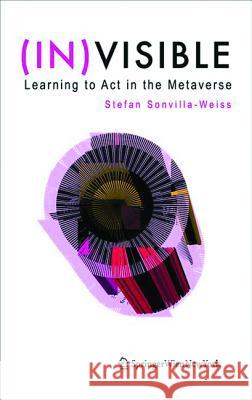
(in)Visible: Learning to ACT in the Metaverse
ISBN-13: 9783990431900 / Angielski / Miękka / 2008 / 168 str.
Seemingly at the end of our campaign of discovery, conquest and exploitation, the virtual, infinite, digital spaces are being conquered. This book looks ahead to future developments in the merging of real and virtual interaction in networked dataspaces.
"How can real and virtual space interactions generate novel forms of communicative, creative and social practices in global connected communities?" (Introduction) Stefan Sonvilla-Weiss attempts to answer his own rhetorical question in this rather deceptively slim volume. The book is deceptive in that at only 168 pages of pocket book size it seems slim, but every page is packed with tight, fast moving discussion and information. The book leans towards academic cultural theory discourse, however, I feel that it is still accessible to the general reader interested in the phenomenon of the Internet and its global citizens. "Multiple person-computer interfaces far exceed in their complexity and lack of overview the discussion currently taking place about possible social, aesthetic, legal and political effects on individuals and communities" (back cover). Learning to Act in the Metaverse explores the numerous possibilities and ramifications that open up when we engage with the new dataculture or Metaverse. 3D online worlds such as Second Life are often thought of as exclusively the Metaverse, but as Sonvilla-Weiss explains all aspects of the data driven, digitally networked (YOU)niverse are part of the Metaverse. How we act, behave (or misbehave) and learn to interact in the Metaverse is only just beginning to be analysed and articulated in books such as this. The book has a Bibliography, Notes to Chapters but no Index. There are five chapters as follows: Chapter 1 - Global Data Space: Early Visionaries discusses the work and futuristic vision of some great thinkers concerned with information and its dissemination, especially that of Paul Otlet. Chapter 2 - Mirror Worlds: The Universe In a Box? Explores such matters as the massive collection and exponential growth of data, Google Earth's global mapping and invasion of privacy, and the Dymaxion work of Buckminster Fuller. Chapter 3 - Lifelogging: A Concept of Sousveillance? Discusses the changes in privacy and surveillance that the Metaverse has brought about. Lifelogging, being always and intimately connected with audio and visual storage of self-data, is analysed in detail. Chapter - 4 Blending the Real and the Virtual looks at how we navigate around virtual space, the concept and changing features of personal space, and the ways we communicate, participate and exploit the virtual and consequently the real. Chapter - 5 Transitory Processes in a sense brings the previous chapters together, especially from the perspective of education. The art-science coalition is discussed in detail, as is the increase in complexity and the way we might handle or operate from within this complexity. Professor Sonvilla-Weiss is head of the international MA program in ePedagogy Design - Visual Knowledge Building; this brings a slight pedagogical slant to his analysis of the Metaverse throughout the book. He points out, particularly in the final chapter, the benefits and pitfalls of eEducation as they have presented themselves in his real experience of teaching via the various tools of the Metaverse - Internet, VoiP, telematic conferencing, Skype, mobile phone communication, Face Book, emailing and so on. I agree with his conclusion that the potential for eLearning is truly amazing but we still have a way to go yet to bring it up to the quality and efficacy of face-to-face communication in many cases. As previously mentioned, I think this book is suitable for anyone interested in the cultural and social issues which the now ubiquitous "Net" has raised. However, the book is especially recommended to Cultural Theorists, Metaverse designers (of both hardware and software) and all those involved in education. I recently attended, in Second Life, a conference/lecture regarding the future of virtual education. World time differences notwithstanding, it was a great success and in itself highlighted the incredible potential and benefits of virtual education for certain disciplines. Second Life has the great Metaverse advantage of the individual being physically present, via your personalized avatar (alter ego?) at the function. This incurs all the same social aspects of relating and communication as in the real world - manners, personal space delineation, respect for other's opinions, dressing appropriately for the occasion (well perhaps!) and social networking. This latter point I have found to be as interesting and effective, if not more so, than in real life. All these matters, technical prowess aside, are aspects of Learning to Act in the Metaverse. Leonardo on-line, reviewed by Rob Harle, Australia










